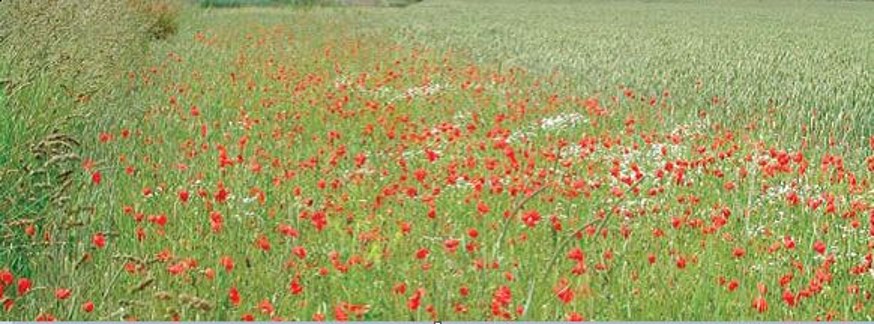Supporting guidance for Unharvested Conservation Headlands for Wildlife
Date published: 30 March, 2015
Unsprayed and unharvested conservation headlands can improve habitat diversity in arable fields. Conservation headlands of cereal crops are left unsprayed, allowing broad-leaved plants to establish and insects that live and feed on the plants to survive.
Careful selection of fields for this option is important in order to avoid a build-up of problem weed species. The option to rotate the location of the conservation headlands will help discourage the build-up of weeds.

Wildlife benefits
Allowing broad-leaved plants to establish at the edge of cereal crops can help rare arable plants, boost insect numbers and provide ideal feeding habitat for farmland birds.
Rare arable plants struggle to survive where fertilisers and herbicides are used in intensive arable landscapes. Arable plants, such as corn spurry, have declined significantly but can still be regularly found in unsprayed headlands.

Broad-leaved arable plants support many beneficial predatory insects which predate crop pests. Insects are an important food source for farmland birds. Chicks of most farmland birds depend on insects for food and grey partridge chicks require large numbers of protein-rich insects to survive and grow in their first two weeks of life. Sawfly larvae are frequently found in conservation headlands and provide an excellent source of food for grey partridge chicks.
Leaving the margin unharvested provides further benefits to wildlife. An unharvested margin is a good source of food and cover for birds through the winter. Many farmland bird species will feed on the cereal seed, and the seeds of broad-leaved plants will further boost food availability through the winter.
Establishing and managing conservation headlands
- conservation headlands are best established next to other habitats, such as tussocky grass margins, beetle banks or hedges, as these habitats provide overwintering feeding ground for insects
- avoid locating the headlands along shaded field margins (for example, next to an area of woodland)
- there is no fertiliser restriction on the headland but not applying fertiliser to the headlands is strongly recommended. This benefits less competitive, rarer arable plants and discourages problem weeds
- choose fields with lighter soils where there are no issues with problem weed species
- headlands can go all the way around a field or just along one edge of a field
- rotate the location of conservation headlands to avoid the build-up of problem weeds
- in corn bunting areas headlands greater than 10 metres wide may also provide safe, attractive nesting habitats for corn buntings, which prefer to nest in crops with dense ground cover, usually beyond 10 metres from the field edge
Additionally, consider:
- research from the Game and Wildlife Conservancy Trust suggests that at least three per cent of arable habitat needs to provide insect-rich brood-rearing cover (for example, conservation headlands and wild bird cover) to help halt decline among grey partridge

Further information
Further information on the benefits of conservation headlands and how to establish them is available:
